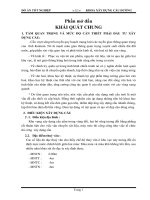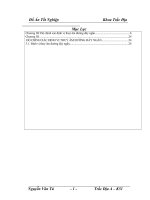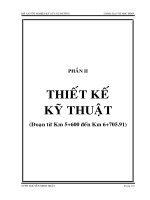Đồ án đường _ Đồ án tốt nghiệp
Bạn đang xem bản rút gọn của tài liệu. Xem và tải ngay bản đầy đủ của tài liệu tại đây (821.2 KB, 63 trang )
GRADUATION THESIS
ROAD AND HIGHWAY SECTION
CONTENTS
…
Page 1
GRADUATION THESIS
ROAD AND HIGHWAY SECTION
CHAPTER 1
INTRODUCTION
1.1 BACKGROUND OF THE PROJECT
Project name: Highway investment project
Location: Alignment A-B is located in Khu pho 6A, Dak Nong province.
Project manager: Ministry of Transport
Consultant organization: The University of Transports and Communications
Designer:
1.2 OUT LINE OF THE PROJECT
1.2.1 Objectives of the Project
The main objectives of the Project implementation can be summarized as
follows:
The new road is strategically located at Dak Nong province to contribute to the
economic and social development of the Central Highland region in Vietnam.
Concerns and improvement for the traffic safety, job opportunity and living
level of the local residents in the project area is an important factor in the sense to
share the profits of project.
1.2.2 The base to carry out the project
Base on Dak Nong Highway investment and construction policy.
Base on traffic volume investigation and forecast data.
Table 1-1: Forecast traffic volume
No
1
2
3
4
5
6
7
8
…
Vehicle
Heavy Truck 3
Heavy Truck 2
Heavy Truck 1
Medium Truck
Light Truck
Small Bus
Big Bus
Car
Summary
Fleet
Composition %
2
2
1
9
1
17
2
64
98
Page 2
Traffic
components
(veh/day)
13
13
6
57
6
107
13
403
630
GRADUATION THESIS
ROAD AND HIGHWAY SECTION
1.3 DOCUMENTS USED FOR DESIGNING
No.
Name of Standards
Standard Ref. No
Survey
T32
Land survey in construction – general specification
TCXDVN3092004
G09
Geotechnical Boring Investigation Standard
22TCN259-2000
G13
Geological survey for waterway work standard
22TCN260-2000
Road Design
R16
Specifications for road design
TCVN4054-2005
R28
Rural road design standard (used for frontage road and 22TCN210-92
collector road)
Pavement
P18
Vietnam Pavement standard of flexible structures
22TCN211-06
Water Treatment
W11
Flood flow calculation
22TCN220-95
Safety
T
Roadway traffic signal regulations
QC41-2012
1.4 STUDY SCOPE
The study scope has limited in direction route, it bases on the long-term
transport programming of the area in the future.
CHAPTER 2
PROJECT AREA IN DAK NONG PROVINCE
2.1 INTRODUCTION AND GEOGRAPHICAL CONDITIONS
Dak Nong Province is located in the at the southern gateway of Tay Nguyen,
Dak Nong has National Highway 14 linking Ho Chi Minh City and the Eastern
provinces with the Central Highlands, 230 km north of Ho Chi Minh City and away
from the city. Dak Nong has a network of rivers, streams, lakes, dams distributed fairly
evenly. This is a good condition to exploit water resources for agricultural production,
…
Page 3
GRADUATION THESIS
ROAD AND HIGHWAY SECTION
industry, construction of hydropower projects and to serve people's needs. Flood
regime: Bear the strong influence of Krong No River.
2.2 TOPOGRAPHICAL CHARACTERISTIC
The topography is quite favorable, coMPared to other midland districts and
mountainous areas of the province. The district has few mountains with elevations
ranging from 500 m to 700 m. The alignment is mainly along the contour line, cut
through many stream so the different kinds of embankment can be used such as full
fill, full excavate, half cut half fill, L shaped cut…
Base on the results of topographical surveys, test drilling, field testing and
laboratory tests on the collected samples, the stratification of the area was divided into
layer as following:
-
Organic soil was found on the ground surface. The thickness of this layer
ranges from 0.2m to 0.4m.
Basaltic soil: this layer distributes along alignment. The thickness of this layer
ranges from 2m to 4m.
Weathered rock: the color of this layer is yellowish brown, reddish brown. The
thickness ranges from 3 m to 5m.
Bed rock: the most popular bed rock in this area is basalt rock.
The region where the project is carried out has stable geologic condition.
Dynamic geological phenomena barely occur or in such small scale that they have no
influence on the alignment.
2.3 CLIMATIC CONDITIONS
This section is prepared to:
-
To find possible material sources;
To determine the suitability for quality requirements;
To determine the possibility of supply for required magnitude in the project;
To provide necessary information to estimate the project cost.
The Project goes through the area where constructional material sources are
popular and advantageous. The exploitation, supply and transportation conditions are
very convenient.
-
…
Soil: sandy clay volume is quite large. Sandy clay has high strength.
Employment, transportation is convenient. So, it is used for embankment very
well.
Page 4
GRADUATION THESIS
-
-
ROAD AND HIGHWAY SECTION
Stone: The quality of stone is quite good and satisfies. Resistance strength is
rather high. There are some quarries with large volume. Sand: the quantities are
large. The exploitation, supply and transportation are quite convenient.
Water: is sufficient for construction.
Figure 2.1: Diagram of Temperature – Humidity
…
Page 5
GRADUATION THESIS
ROAD AND HIGHWAY SECTION
Figure 2.2: Diagram of Rain fall – Evaporation
…
Page 6
GRADUATION THESIS
ROAD AND HIGHWAY SECTION
Figure 2.3: The wind flower schema
2.4 HYDROLOGY
Hydrology of the region is not complex. The alignment cuts through a stream.
The flow volume of this stream is not so high. Standing water phenomenon does not
occur.
It locates Kien Duc buk district. Topography of the section is generally downy,
mainly forest. Therefore hydrological regime depends on local rainfall and the
irrigation works.
In research region have only stream system, ditch system.
…
Page 7
GRADUATION THESIS
ROAD AND HIGHWAY SECTION
2.5 DETERMINATION OF ENVIRONMENT
The following aspects stated in the General Requirements, Section 01700 Environmental Control and Protection should be complied for borrow pits.
-
Air quality and dust
-
Water quality
-
Waste and soil contamination
-
Aesthetic problem
-
Other environmental aspects
2.6 TRAFFIC CONDITIONS OF THE REGION
Dak Lak province has nearly 5000 km roads. In which, national road is 398 km
(7.96%), province road is 460 km (9.2%), district road and commune road is 4000km
(82%).
…
Page 8
GRADUATION THESIS
ROAD AND HIGHWAY SECTION
CHAPTER 3
TECHNOLOGY FACTORS
3.1 DETERMINE ROAD LEVEL
3.1.1 DESIGN TRAFFIC VOLUME
According to the highway specification TCVN 4054-2005 then: Design traffic
volume is number of the passenger cars converted from all the vehicles which is
forecasted to pass a cross section of the road during the time unit in the computing
year ( the 15th year in this project).
3.1.2 ROAD LEVEL
Design traffic volume is number of the passenger cars converted from all the
vehicles which is forecasted to pass a cross section of the road during the time unit in
the computing year. Formula:
∑( a N )
i
Nde =
i
Where: Nde: Design traffic volume (Veh/day)
Ni: Volume of vehicle type i in future year
Ni = Nip x(1+q)t
Nip: Volume of vehicle type at the present
q: Traffic growth = 7%
t: Calculated time = 15 (years)
ai: Equivalence factor from vehicle type i to passenger car.
No
Vehicle
1
2
3
4
5
6
7
8
Heavy Truck 3
Heavy Truck 2
Heavy Truck 1
Medium Truck
Light Truck
Small Bus
Big Bus
Car
Summary
…
Fleet
Composition
%
2
2
1
9
1
17
2
64
98
Traffic
component
s (veh/day)
13
13
6
57
6
107
13
403
630
Page 9
PCU
equivalent
factors
3
3
2.5
2.5
2.5
2.5
3
1
design traffic
volume (Nqd)
38
38
16
142
16
268
38
403
958
GRADUATION THESIS
ROAD AND HIGHWAY SECTION
The equivalent PC volume in the designed year (the 15th year) is :
N15 = N1 (1 + q)15 - 1
= 958 x (1 + 0.07)14
= 2469 (vehicle/day)
So the design traffic volume N de = 2469 (vehicle/day) < 3000.According to
TCVN 4054-2005, the road level:
- Base on the importance of the road is connecting economic and politic centers of
the province
- Base on the future development plan of the province related to transport and
communication’s developments
So, the road level chosen is: IV, design Speed is chosen 60 km/h.
3.2 CAPACITY OF THE ROAD.
The capacity of the road, (N) is maximum number of vehicle that can be able to
pass continuously through any cross section during time unit.
N = vehicle per day (VPD) or vehicle per hour (VPH)
3.2.1 IDEAL CAPACITY OF THE ROAD.
The ideal capacity of the road, Nlt is the capacity which is determined in ideal
condition (including the road condition and vehicle condition)
+ Assumption: vehicle continuously move on the road, the same kind of vehicle
and speed, the distance between two adjacent vehicle is constant and equal to L o,
which is required so sufficient that if any vehicle suddenly stop then the driver of the
followed on keep in time to perceive and put on the brake to stop safety. L o is called
kinetic size of vehicle.
+ Schema, refer to figure 3-1
+ Calculation
Formula:
NLT =
…
1000V
Lo
( Veh/h).
Page 10
GRADUATION THESIS
ROAD AND HIGHWAY SECTION
v
v
i=0
Lo
Figure 3.1 calculating the ideal capacity of the road
Where:
- NLT : Ideal capacity of the road (Veh/h)
- V : design speed (km/h)
- Lo : kinetic size of vehicle (m).
Lo = lpu + Sh + lo + lx
Where:
- l
pu
: distance of psychological reaction, calculate from the driver sight a
obstructive object in his path then just time to put on the brake to stop. And tpu = 1 (s)
l pu =
v(km/h)
(m)
3.6
- lx : vehicle length lx = 6 m
- lo : safe distance lo= 5 m
- Sh : braking distance, is calculated:
Sh = S2 =
1000V
K ×V 2
254( ± i )
Substitute them to calculated formula Nlt, we have:
N lt =
1000V
V
K ×V 2
+
+ l x + lo
3.6 254( ϕ ± i )
Where:
- K: Factor of brake using, with passenger car K=1,2
- V: design speed V= 60 km/h
- i : gradient of the road, in normal condition i = 0
- ϕ : longitudinal coefficien of friction, in favourable concision ϕ = 0.7
So :
…
Page 11
GRADUATION THESIS
N lt =
ROAD AND HIGHWAY SECTION
1000 × 60
60
1, 2 × 60 2
+
+6+5
3, 6 254(0, 7 ± 0)
=1155 (veh/h)
3.2.2 ACTUAL CAPACITY OF THE ROAD.
The actual capacity of the road, Ntt is the capacity which is determined in the
actual condition of the road and traffic.
+ The actual capacity (Ntt).
The actual capacity is equal to
( 0.3 ÷ 0.5) N lt
3.3 SPECIFIC GEOMETRY OF CROSS SECTION.
3.3.1 GENERAL INTRODUCTION.
Cross section is significant component for describing the road shape which is
changed depending on the terrain condition.
Pavement consist of carriageway and shoulder and median (if need).
When design speed is larger or equal to 40 km/h, shoulder must be treated.
In the project, median is not located and shoulder is treated.
3.3.2 DETERMINE THE NUMBER OF LANE.
Determine the number of lane is to specify the carriageway fited traffic demand
(road capacity satisfies the traffic volume).
According to the specification TCVN 4054-2005 we have:
The number of lane is determined by the formula:
nl =
N ph
z.N cl
Where:
Nph : design traffic volume at peak hour
Nph = (0.1÷0.12). Ntbnăm .
Ncl : the capacity of the lane.
Z: traffic serving rate (degree of using capacity) Z = (0.55-0.77)
According to TCVN 4054-2005, with the 60km/h design speed we have
Z=0,77
…
Page 12
GRADUATION THESIS
So: nl =
0,12
0, 77 × 1000
ROAD AND HIGHWAY SECTION
x 2469 = 0.53 (lane)
Based on terrain condition, economic-social plans, we choose 2 lanes.
3.3.3 LANE WIDTH.
Lane width and condition of the road surface have a significant influence on the
safety and comfort of the traffic.
Lane width is determined basing on dimension and speed of vehicle.
Carriageway width is determined basing on the number of lane, lane width,
distance of two vehicles in the opposite direction.
a
x
x
l2
l2
c
y
Figure 3-2 Determine the lane width
- a: body width
- c: Distance between two wheels
- x : Distance from edge of the body to the median
- y: Distance from the wheel to edge of part that the truck runs on
- l2: lane width, l2 =(a+c)/2+x+y
Where:
x = 0.5 + 0,005V (m)
y = 0.5 + 0,005V (m) with driving contrariwise
l2 =(a+c)/2+ 1 + 0,01V
With design speed, V =60(Km/h) ⇒ l2 =0,5x(a+c) + 1,6 (m)
a. Calculating for truck.
a=2,5
c=1,8
l2= 0,5x(2,5+1,8)+1,6 = 3,75 (m)
…
Page 13
GRADUATION THESIS
ROAD AND HIGHWAY SECTION
Carriageway width = 2 x l2 = 2×3,75= 7,5 (m)
b. Calculating for passenger car.
a= 1,6
c=1,2
l2= 0,5x(1,6+1,2)+1,6 = 3 (m)
Carriageway width = 2 x l2 = 2×3 = 6 (m)
According to standard TCVN 4054-2005 we have main parameters of cross section:
+ Number of lane
+ Lane width
: 2 lanes
: 3 (m)
+ Carriageway width
: 6,0 (m)
+ Shoulder width
: 2 x 1,5 (m)
+ Roadway width
: B = 6 (m)
+ Road bed width
: B = 9 (m)
Shoulder is the surfaced strip of roadway immediate adjacent to the carriageway
edge.
The faction of shoulder:
+ As a widening part of pavement to increase the safety and reliability for
vehicle operation.
+ For emergency stopping.
+ Temporary extra traffic lanes during road maintenance or carriageway
reconstruction.
+ For increasing the sight capacity on the road.
+ As a structural support to the pavement.
+ As a manner for increasing LOS (level of service) and capacity of the road.
Shoulder structure:
Shoulder consists of treated strip and untreated strip. Untreated strip is edge strip
of roadway which is rounded or unrounded and usually grassed (0.5-1m). Treated
shoulder (hard strip) should be flush and the same construction with carriageway to be
able to support vehicles under all weather condition, so that there are no skidding or
rutting problems when driving on their surfaces. Treated shoulders also serve all types
of non-motorized vehicle.
…
Page 14
GRADUATION THESIS
ROAD AND HIGHWAY SECTION
According to Viet Nam standard TCVN 4054-2005, with road level is level III
and design speed is 60 km/h, shoulder width is 1,5 (m) and treated shoulder width is 1
(m).
3.3.5 CROSS SLOPE (CROSS FALL).
In order to drain surface water from the pavement and avoid pounding in surface
deformations they create a cross slope for central strip or they make the convexity of
pavement and it is termed “camber”.
Depending on the type of pavement surface and the treated shoulder part is
usually the same construction with carriageway. In order to satisfy favorable
execution, cross slope of treated shoulder is the same slope with pavement.
According to TCVN 4054-2005, we choose:
+ Cross slope of carriageway: 2%
+ Cross slope of treated shoulder: 2%
+ Cross slope of soil shoulder: 5%
3.4 DETERMINE SIGHT DISTANCE.
Sight distance is minimum visible distance in front of the driver. It is very
important to calculate and provide the driver with the sign distance so sufficient that he
can treat safety any case which suddenly happens when car moving on the road.
Sight distance calculations, the height of the driver’s eye and height of the object
are considered to be 1.0 (for the same direction) or 1.2m (for opposite direction) and
0.1 m above the road surface respectively.
3.4.1 STOPPING SIGHT DISTANCE (SSD).
Stopping sight distance S1 needs to be computed so enough that when driving, the
driver sight a obstructive object in his path the just in time to put on the brake to stop
the vehicle at point which is far from the object a safe distance l o.
Computing sight distance:
…
Page 15
GRADUATION THESIS
ROAD AND HIGHWAY SECTION
Scheme 1
Sh
Lpr
L0
1
1
S1
Figure 3-3: Determine stopping sight distance
According to this scheme: S1 = Lpr + Sh + L0
Computing sight distance depend on V(Km/h), we have:
S1 =
V
3.6
kV 2
254(ϕ ± i )
+
+ Lo
Where:
- lpư : Distance of psychological reaction: lpr =
- Sh : Braking distance:
Sh =
kV 2
254(ϕ ± i )
V
3.6
(m).
.
- L0 : Safety distance: L0 = 5÷10 m, choose: L0 = 5 m.
- V : Design speed: V = 60 Km/h.
- k : coefficient of the brake using, k = 1,2 for passenger car.
- ϕ : Longitudinal coefficient of friction: ϕ = 0.5.
- i : Gradient of road, for unfavourable condition, we choose: i =7%
⇒ S1 =
60
1.2 × 60 2
+
+5
3.6 254 × (0.5 − 0.07)
= 46,96( m )
According to TCVN 4054-2005, Stopping sight distance is setted: S 1 =75m
⇒ So we choose the stopping sight distance is: S1 =75 m .
…
Page 16
GRADUATION THESIS
ROAD AND HIGHWAY SECTION
3.4.2 OPPOSING SIGHT DISTANCE (OSD).
Opposing sight distance S2 needs to be computed so sufficient that when moving
on the single lane or narrow two lanes, the driver discovers an oncoming vehicle and
just in time to stop the vehicle safely.
Computing sight distance:
22
Figure 3-4: Determine opposing sight distance
S2 = 2Lpr + L0 + Sh1 + Sh2
Computing sight distance follows: V(Km/h):
S2 =
V
kV 2
+
+ Lo
1.8 127(ϕ 2 − i 2 )
60
1.2 × 60 2 × 0.5
+
1.8 127(0.5 2 − 0.07 2 )
=
+ 5 = 108.75 m
According to TCVN 4054-2005, Opposing sight distance: S2 = 150 m
⇒ So we choose: S2 = 150 (m).
3.4.3 AVOIDING SIGHT DISTANCE (ASD).
Avoiding sight distance S3 needs to be computed so sufficient that vehicle 1 is
…
Page 17
GRADUATION THESIS
ROAD AND HIGHWAY SECTION
moving on the path of vehicle 2, detects the vehicle 2 and keep in time to turn to its
lane for avoiding safely.
Calculating sight distance:
r
r
Figure 3-5: Determine avoiding sight distance
Avoiding sight distance is calculated by formula:
S3 = 2. lpr + Sh1 + Sh2+ lo
According to this scheme:
Sh1 = Sh2 = 2
S3 =
V
1.8
+4
ar
ar
+ lo
Where:
- a : Distance between two center of two lanes a = 3 m
- r : Turning radius
r=
V2
127(ϕ o − in )
ϕo
…
=
60 2
127(0.35 − 0.02)
: lateral coefficient of friction,
= 85.9 ( m)
ϕo ≈ 0.7ϕ ≈ 0.7 × 0.5 = 0.35
Page 18
GRADUATION THESIS
S3 =
=>
ROAD AND HIGHWAY SECTION
60
+ 4 3 × 101.2 + 5 = 102.54(m)
1 .8
- in : cross fall. in = 2%
- V: design speed, V = 60 (km/h)
According to TCVN 4054-05, Avoiding sight distance: S3 = 150 m
⇒ we choose: S3 = 150 (m)
3.4.4 PASSING SIGHT DISTANCE (FULL OVERTAKING SIGHT
DISTANCE) (FOSD).
Passing sight distance S4 needs to be computed so sufficient that vehicle 1
(overtaking vehicle) would like to pass the vehicle 2 (on two lanes road), detects the
opposing vehicle 3 and has to return safely to its correct lane.
S1-S2
L1
2
Figure 3-6: Determine passing sight distance
In the nomal case:
S4 = 6V = 360 m
In the compulsory case: S4 = 4V = 240 m
According to TCVN 4054-05, passing sight distance: S3 = 350 m
⇒ We choose: S3 = 350 (m)
…
Page 19
1
GRADUATION THESIS
ROAD AND HIGHWAY SECTION
* Appication
+ Stopping sight distance is basic value which has to be caculated in any case of
the design.
+ Opposing sight distance is applied th vertical curve on the road without
median and sight distance offset.
+ Avoiding sight distance is effect on the roads having the poor pavement and
not used in the standard of America, UK, France, etc.
3.5 DETERMINE MAXIMUM GRADES OF THE ROAD.
3.5.1 DETERMINE MAXIMUM GRADES BASE ON DYNAMIC
FACTOR.
Calcultion principle: Pulling force of vehicle must be larger than summary of
impediment force. Maximum grade is calculated depending on the capacity of vehicle
type that can be overtaking slope of the road. Otherwise, maximum grade is calculated
depending on dynamic factor. By formula:
δdv
gdt
Dk=f i
=f i
δ
×j
g
Where:
- Dk : Dynamic factor.
- f : rolling impediment coefficient: f = 0,02 (asphalt concrete pavement).
- i : grade of the road ( %).
- j : relative acceleration of vehicle. j =
dv
dt
- : coefficient considering the rotation of the machine (=1.03-1.07).
- g : gravity acceleration, g = 9.81 m/s2
( (+) when go up, (-) when go down)
Assumption: the vehicle have uniform motion, we have: j = 0
To compute in unfavorable condition: when vehicle goes up the slope.
Dk f + i ⇒ idmax= Dk – f = Dk – 0.02
…
Page 20
GRADUATION THESIS
ROAD AND HIGHWAY SECTION
With Vtt = 60 km/h, To look up the chart of dynamic factor for some type of
vehicles and (in Road design book) and substitute them to above formula, take the
table:
Type of vehicles
Car
1-axis truck
2-axes truck
3-axes truck
Vehicles
Vonga
Dmax
0,085
imax =Dmax-f
6.85
Zin150
0,03
1
Maz200
0,035
1.5
Maz500
0,04
2
Table 3-2: Dynamic factor and maximum grades
Because cars are outnumbered others vehicles, we use car for design vehicle, so
base on this table, the idmax = 7 %
3.5.2 DETERMINE MAXIMUM GRADES BASE ON CLINGING
FORCE.
According to the condition of clinging force between the types and carriageway,
in order to vehicles move safety, the clinging force between the types and carriageway
must larger than the pulling force of vehicle. So maximum grades of the road must
smaller than grades that is calculated basing on the clinging force (i b). ib is computed in
case the pulling force of vehicle equal to the clinging force between the types and
carriageway.
Assumption: the vehicles have uniform motion, we have: j = 0
To compute in unfavorable condition: when vehicle goes up the slope.
D’ = f + ib →
We have: D’=
ib = D’ - f
ϕ .Gb − Pw
G
>D
Where:
- D’ : Dynamic factor
- ib : Grade of the road (base on clinging force).
- G : Whole vehicle load
- Gb : The load in positive wheel:
+ Truck:
Gb = ( 0.65 ÷ 0.7 ).G
+ Passenger car:
Gb = ( 0.50 ÷ 0.55 ).G
- ϕ : longitudinal coefficient of friction. In the most unfavorable case: ϕ = 0.3
…
Page 21
GRADUATION THESIS
ROAD AND HIGHWAY SECTION
- Pw: Air impediment force
PW =
K .F .V 2
13
(kg)
Where:
- K: air impedient coefficient, depending on air density and vehicle shape
- F : Area of the maximum cross section of vehicle which is perpendicular to
moving direction (air impediment area, m2)
F = 0.8BH
Where: B: Vehicle width
H: vehicle height
- V: Relative speed of vehicle in comparing with air. In case, there is no wind
Vtt=60km/h
To look up type of vehicles datum and calculate. We set a table as follows:
Vehicle type
Car
Truck (10-12t)
Truck (8-9t)
Truck (4-6t)
K
F(m2)
Pω
G(Kg)
Gk(Kg)
D’
0,03
2.88
23.9261 3636
1999.8
0.2684
0,04
9
162
13625
9537.5
0.3381
0,05
9
162
8250
5775
0.3303
0,06
9
162
5350
3745
0.3197
Table 3-3: Grades of the road depending on clinging force
ib
0.2464
0.3161
0.3084
0.2977
The condition for vehicle not to slip and lose balance is ib ≥ imax . All the
condition checked in this table is good.
According to Viet Nam standard TCVN 4054-2005, with design speed is 60
km/h: we choose grade of the road: 7%.
Combine calculation and standard, we propose to choose grade of the road is 7%
in order to design AB alignment.
3.6 DETERMINE MINIMUM RADIUS OF HORIZONTAL CURVE.
The aim of designer is to determine the component of road to fit the demand of
serving through, safely, smoothly, economically and aesthetically the traffic. That is
why, in principle the radius of curve should be as great as possible. However, in many
situations, depending on the terrain condition it is needed to use sharp curve to avoid a
too great earthwork or disadvantage condition…. In that case, in order to be safe for
…
Page 22
GRADUATION THESIS
ROAD AND HIGHWAY SECTION
vehicle moving on outside lane of curve, the pavement should be designed the same
cross-fall inclining to the center of curve (superelevation).
3.6.1 MINIMUM RADIUS OF CURVE WITH SUPERELEVATION.
In disadvantage case, minimum radius of horizontal curve is calculated with
superelevation 8%.
Rmin =
V2
127(μ + i scmax)
Where:
V: Design speed, V = 60 km/h
µ : Lateral force coefficient, normally: µ = 0.15
iscmax : superelevation, iscmax = 7%
Rmin =
60 2
=
127(0.15 + 0.07)
128.8 m
According to TCVN 4054-2005, minimum radius of curve with superelevation
7% is 125 m. We propose: Rscmin = 125 m.
3.6.2 MINIMUM RADIUS OF NORMAL CURVE.
Normal curve is the curve in which all cross section is normal cross section
(without superelevation). Minimum radius of non-superelevation curve is symbolized
RminKSC. And RminKSC is calculated by formula:
Rmin =
V2
127( μ − i n )
Where:
V: Design speed, V = 60 km/h
µ : Lateral force coefficient, normally: µ = 0.08
In : cross fall, in = 2%
RminKSC =
60 2
=
127(0.08 − 0.02)
472(m)
According to TCVN 4054-2005, minimum radius of normal curve 1500 m. So, we
propose: RminKSC = 1500 m.
…
Page 23
GRADUATION THESIS
ROAD AND HIGHWAY SECTION
3.6.3 RADIUS OF CURVE WITH NORMAL SUPERELEVATION.
In normal case, radius of horizontal curve is calculated with superelevation 4%.
Rmin =
V2
127( μ + i sc )
Where:
V: Design speed, V = 60 km/h
µ : Lateral force coefficient, normally: µ = 0.135
isc : superelevation isc = 4%
Rmin =
60 2
=
127(0.135 + 0.04)
149 m
According to TCVN 4054-2005, minimum radius of curve with superelevation
4% is 250 m. So, we propose: Rscmin = 250 m.
3.7 WIDENING IN CURVE.
While the vehicle moving in the curve, each tyre move in a different path: the
constant rear axis always lead to the radial while the front axis and rear axis make an
angle, so the vehicle need a bigger widening in curves. Therefore, to make the moving
of vehicle as comfortable as moving in the straight line, the small-radius curves (<250
according to TCVN 4054-05) need to have widening. The number of that widening
have to make sure the distance between the car and the shoulder, between two cars just
like in the straight line.
Figure calculating widening in the curve
Refer to Figure, we have: Eg = e1 + e2 ≈ 2e2 = L2/R
…
Page 24
GRADUATION THESIS
ROAD AND HIGHWAY SECTION
Geometric widening is widening in static situation. In fact, it needs to be
considered in the condition of vehicle moving. In that case, due to the influence of
speed, by expriment we have expression of widening (Ev)
R
EV = 0.1V/
Hence by, total widening E is:
E = Eg + Ev =
L2 0.1.V
+
R
R
With Rmin = 250 m we have:
82
0.1.60
+
250
250
E=
= 0,6m
L: Length from axle’s vehicle to axle of the next one, L=8 m
According to TCVN 4054-05 the widening in the curve with V tk = 60 Km/h, Rmin =
250(m) is 0,6 m
So we choose the widening in the curve is 0,6(m)
3.8 DETERMINE SUPERELEVATION AND SUPERELEVATION
TRANSITION.
3.8.1 SUPERELEVATION.
In sharp horizontal curve, in order to increase the lateral resistance (decrease
effect of centrifugal force), stability of vehicle moving on the outside lane, the surface
of pavement is designed to incline to inside direction of curve. That is termed “super
elevation”.
Super elevation must be designed to fit particular conditions. Super elevation is
calculated depending on design speed and radius of horizontal curve:
i sc =
V2
−μ
127R
Where:
R : Minimun radius of horizontal curve with superelivation
µ : Lateral force coefficient (µ = 0.15: ratherly perceive the curve)
V : Design speed V= 60 km/h
…
Page 25









